This is the fourth piece in a blog series written by Craig Anderson as he documents the design and construction of an off-grid LEED Gold passively-heated home.See post 1 of the off-grid homes blog here, the overview. orpost 2 in the off-grid homes blog here covering design and construction choices. orhere see post 3 in the off grid homes blog about off grid power generation
Being a newcomer to living off of the grid, I did not make the best initial choice for our heating system. In order to help others to not make the same mistakes, I'll both lay out what we did and how it was problematic, as well as how we went about fixing the problems for the future.
What we installed initially
 |
|
Radiant floor boiler © Craig Anderson
|
We installed a hydronic heating system powered by a propane fired boiler (a Trinity LX150). The system has a heated concrete floor in the lower level with four zones (one for each bedroom and one for the bathroom), and two hydronic baseboard registers upstairs. This system provides amazingly warm and comfy floors in the bedrooms when we run the heating system. Some people with heated floors don't get to have the warm foot experience that often with high efficiency homes, but this has not been the case for us. As the house is used primarily as a weekend retreat in the winter, we turn up the heat considerably when we first arrive. We have to wear warm sweaters when we first get in the door, but then have a full day where the floor is toasty warm.
The secondary heating system, and the one that I enjoy using much more, is a free-standing wood stove, a Jotul F3CB to be precise. It is a relatively small (42,000 btu) high-efficiency stove out of Norway, but it is more than sufficient for our well-insulated home. The stove is located in the open concept upstairs, and in just a few hours it can take the 1000 square foot high ceiling space from sweater temperatures to shorts weather.
 |
|
© Bala Structures
|
We have two winters of usage to measure our consumption of propane and wood, and the usage was roughly what was expected. In the 12 months up to November of 2015, we burned 400 gallons of propane across all uses, primarily for heating the house, but also for domestic hot water, the backup generator, and a propane range in the kitchen.
 |
|
|
我猜测其中的75%,大概300加仑的丙烷,被用于太空取暖。2014年到2015年的冬天,我们只烧了不到一捆木柴,去年冬天,我们在那里的大部分时间里,每天都至少有一部分时间在炉子里生着火。在2015-16年,丙烷使用量略有减少,为350加仑,我们再次燃烧了近整整一捆柴火。
The problems associated with the first effort
我们的加热系统最大的问题是它相对复杂和脆弱。我们不是一直在那里运行木炉,这意味着锅炉系统真的需要承担负荷。问题是,该系统需要一个稳定的,相当重要的电力供应,在一年中最困难的时候,光伏发电系统发电。
Running full power, the heating system requires approximately 400W for the boiler and circulation pumps, meaning that if it runs for 10 hours per day (which can happen on the coldest days of winter), the heating system alone needs 4 kWh/day, which is almost the full amount of our target daily electricity budget. The other problem is that the hydronic system is sensitive to freezing, which occurred early in 2013 (our first full winter).
We lost power that winter and had a few frozen water pipes, as well as a break in one of the hydronic heating lines. There was glycol in the mix as an antifreeze, but apparently the installer did not put enough. It did take a very serious set of combined circumstances to bring down the house, consisting of it being the coldest week of the year, we were away for a week visiting family at Christmas, there were several snowy days covering the solar panels and preventing power generation, and the final straw of the backup generator breaking down.
Steps taken to make the house more resilient going forward:
So we have no desire to repeat the emergency situation that we found ourselves in for a good chunk of that first winter, and have taken quite a number of steps in service of making our home more resilient in the face of future mechanical problems. I plan to discuss some of these steps more thoroughly in a future post, so I'll just highlight briefly here those that aren't heat related. What did we do?
-Set the house to send daily emailed status reports giving conditions of the solar system, including power generated, power used, generator run time, battery temperature. These daily reminders tell me how the system is functioning, and I know that if I fail to receive one, that there is a problem with either the power or internet systems.
-Increase the amount of solar panels. During the first winter, the generator was needed relatively frequently over a 6 month period from the fall through the spring, and it was far too often for my taste. Therefore, we doubled the capacity of the solar system.
 |
|
Direct vent propane heater © Craig Anderson
|
Finally, we added a new backup heat source that would not be dependent on either our being there every day or electricity. We did this by using an older, simpler technology - a direct vent propane wall heater. These have been used for many years in garages, workshops, cabins in the woods, as well as in quite a number of off grid homes.
如果我对离网供暖做了更多的研究,或者我得到了更好的建议,我可能会决定从一开始就用几个这样的加热器来满足我们的供暖需求。这些设备的最大优点是它们完全不需要电力就能工作。他们有一个指示灯和毫伏热电堆恒温器,利用温度梯度产生恒温器所需的少量电流,并依靠对流使空气循环通过加热元件。我们已经安装了一个,以提供大部分的基本供暖负荷,并确保房子不会再次冻结,无论电力系统有任何问题。
How to size this new heater? I relied on the boiler company to help make this decision with the original heating system, but this new installation was a much more hands on endeavor for me. We have the good fortune of already having a good energy model of our house, as it was needed for the LEED certification (to be discussed in a future post).
The model gives an estimate of 33,200,000 BTUs of heat needed per year for the whole house, which is about a 70% reduction over a similar sized house built only to code. Heaters are generally rated as per the BTUs/hour that they produce. To get a first approximation of our heating needs, I took the heating load for the year, divided by 100 days to account for the heaviest part of the heating season, divided by 24 hours in a day to account for a heater running full time, which gives:
 |
|
|
This calculation would be assuming that we heat the entire house to 70° Fahrenheit (20° Celsius) with just the wall unit for the entire winter. In actuality, we keep a lower set-point, and this unit will instead keep just a local area of the house at about 65 to 70° F, while allowing the rest of the house to be cooler when we aren't there, and continuing to be heated by the hydronic system.
This calculation is just an estimate of the average heating load, so this amount of heat wouldn't quite be able to keep up with heating the whole house on the coldest days of winter. We selected the Empire DV215 heater, a 15,000 BTU unit, which sits in the central bedroom, radiating heat out to the rest of the lower level.
在安装壁式加热器之后,我发现我们的能源模型还包括了家庭和锅炉系统的供热负荷峰值计算,这实际上与我上面做的计算非常接近。我们房子的峰值供热负荷的HERS计算是23400 BTU/小时。23400这个数字是在一年中最冷的日子里所需的热量,而不是我试图估计的典型冬天的一天。这个峰值负荷计算也显示了我们实际的锅炉规格,最大输出热量为136,000 BTU。这几乎是我们最大供热负荷的6倍,这是过分的,但我一再听说,供暖和制冷承包商通常会过度建造这些系统,我们的房子确实需要比标准家庭小得多的供热负荷。
在使用了整整一个冬天之后,我可以报告说,壁式加热器在可靠性和减少取暖用电量方面取得了惊人的成功。当我们不在城里的时候,加热器基本上能够承担房子里所有的供暖负荷。加热器被放在孩子们的卧室里,设置在67华氏度左右。当我们离开几天后到达时,相邻的房间总是60华氏度或更高,而楼上的温度总是高于50华氏度。从这样的起始点开始,很容易打开锅炉,在木火炉里生火,然后在不超过2小时内脱掉衬衫。
- Off-grid living homes blog post 1: Concept Overview
- Off-grid living homes blog post 2: Design & Construction Choices
- Off-grid living homes blog post 3: All about off grid power generation
NEXT PAGEOff-Grid living homes blog post 5: Appliances, mechanicals & systems


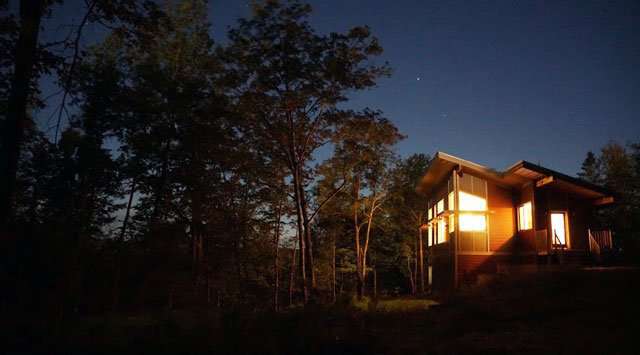













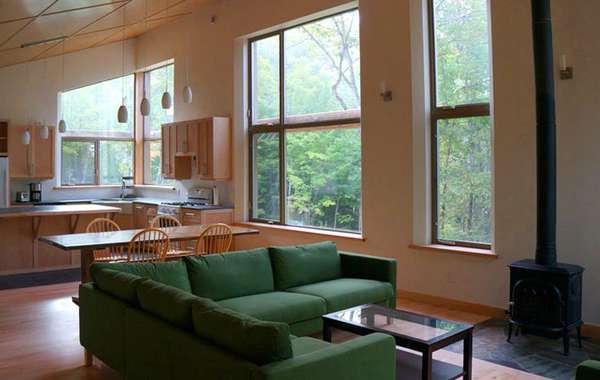
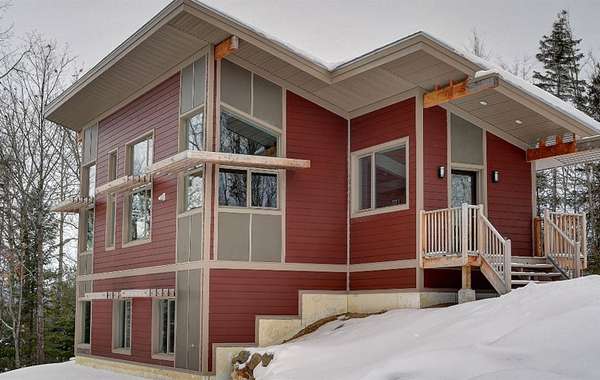
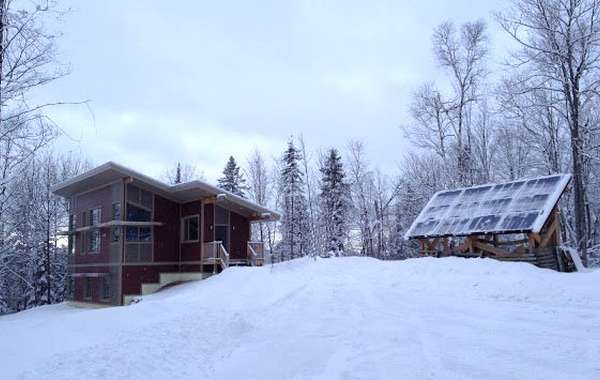
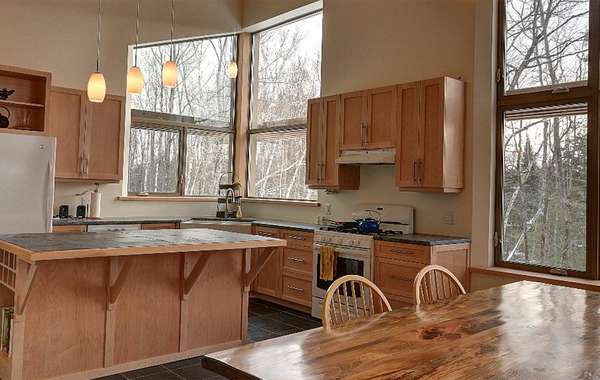
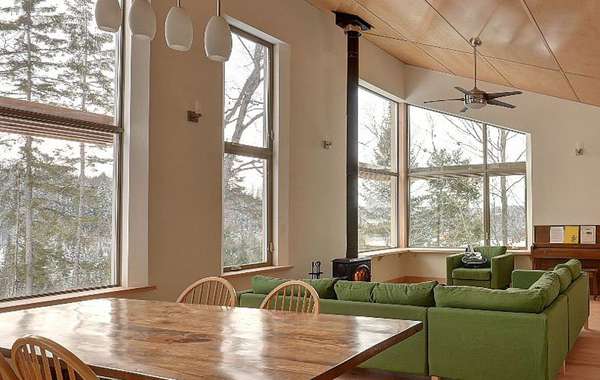
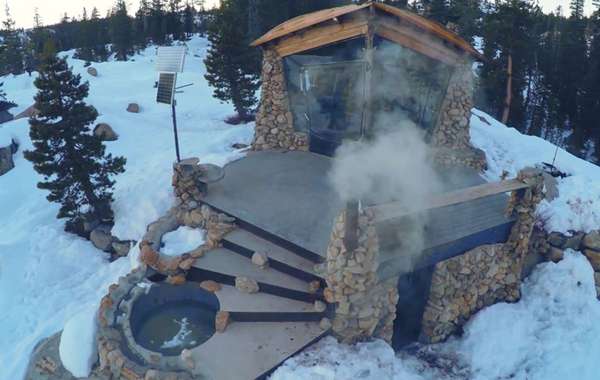
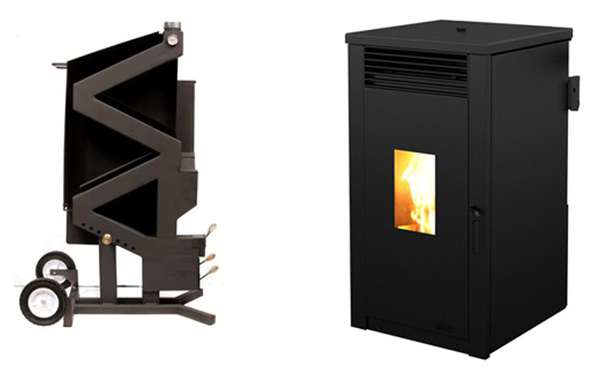
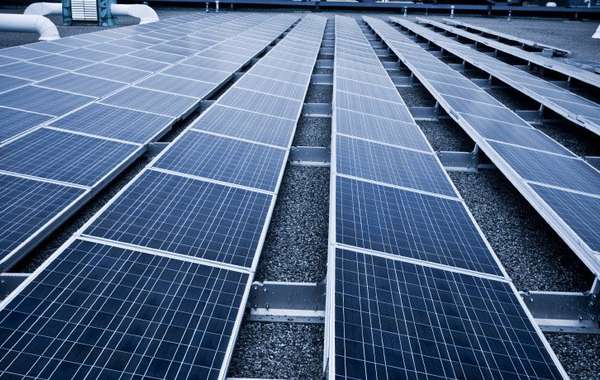
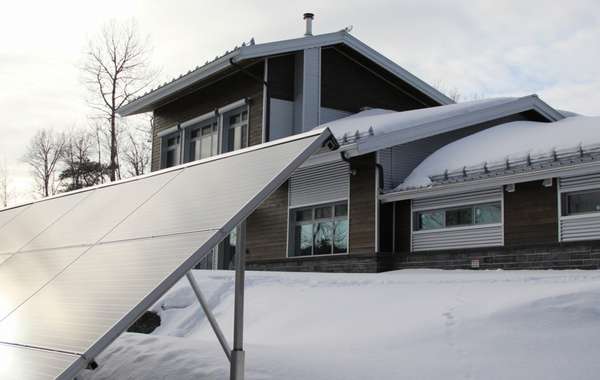
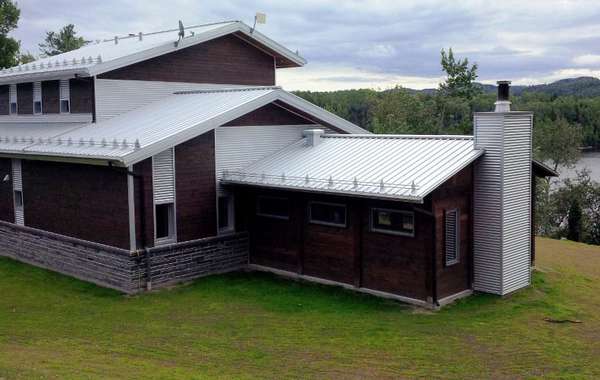
I'm curious what prevented you from going 100% electric, reducing propane consumption entirely? Was it that initially, you had a smaller solar system (which you then doubled)?
An all solar-electric system just can't keep up with the heating loads of early to mid-winter. Even with the expanded 6 kW system there are gray and stormy weeks from November to January with very little solar generation. Our house needs something like 50 kWh per day of heat on the coldest days, and the current system produces an average of only 10-15 kWh per day in the dreariest part of winter. Limited battery storage is a whole other issue, with current costs of around $500 per usable kWh.
The takeaway is that to go solar only on a house like this in a climate like Ottawa's, one needs a much bigger solar array and battery bank. Current costs for the system one would need are ridiculous, but with technology advances and price decreases this may enter the realm of feasibility in a decade or two.
我希望你们的供暖系统能正常工作。我在爱荷华州密西西比河边上的房子很像你的房子。它建于20世纪70年代。主窗户就像你的房子的角落,面向河的景色。虽然我的房子只有一部分没有使用电网,但我做了更多的工作来实现自给自足。有一口井,但水很硬。设有全屋饮用水过滤系统(RO)。值得的。
Also house was all electric but replaced both furnace and AC unit. Went from Electric furnace to propane. Cost 4K but payed for itself in energy savings in less then 4 years. (about $200 a month savings on average). Got courner of house rebuilt as water damage from age ruined windows and frame. Like new house now. Get great passive heat in winter and windows open up in summer.
Can send a pic if you like. Looking at replacing wood stove. I was told the new ones put out 4X the heat and burn half the wood. House is 2000 square feet. Yours look about the same size.
Big difference is I have decks that wrap around the house. Mine is a fixer upper.
Thus does a propane on demand heater use a lot of electricity? We have a Navien and live full time in our off grid int he Canadian winter. I'm wondering how much electricity we are using to heat up our floors. I thought they did not use that much.
嗨,玛丽,产生任何形式的热量都需要消耗大量的能源,无论是热水、底板散热器、强制空气炉还是辐射地板,都将是你家里最大的能源消耗者。我们不是化石燃料的粉丝,但如果你有丙烷,你已经用完太阳能,那么它可以有一个丙烷热水器,而不是增加太阳能电池板,但这是一个非常主观的决定。